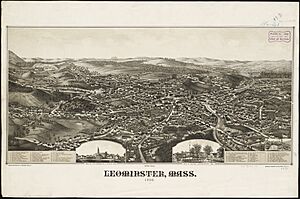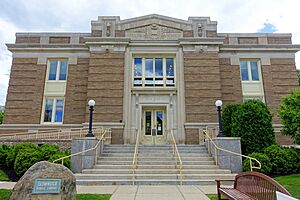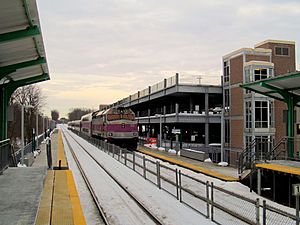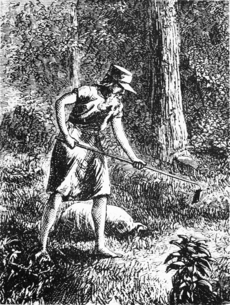Leominster, Massachusetts facts for kids
Quick facts for kids
Leominster, Massachusetts
|
|||
|---|---|---|---|
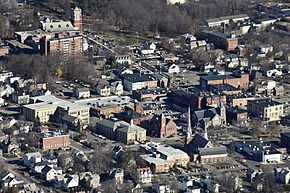
Downtown Leominster
|
|||
|
|||
| Nickname(s):
Pioneer Plastics City
The Birthplace of Johnny Appleseed |
|||
| Motto(s):
We Must, We Can and We Will Be Free.
|
|||
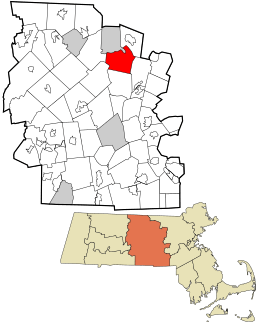
Location in Worcester County and the state of Massachusetts
|
|||
| Country | United States | ||
| State | Massachusetts | ||
| County | Worcester | ||
| Settled | 1640 | ||
| Incorporated |
|
||
| Government | |||
| • Type | Mayor-council city | ||
| Area | |||
| • Total | 29.68 sq mi (76.87 km2) | ||
| • Land | 28.82 sq mi (74.65 km2) | ||
| • Water | 0.86 sq mi (2.22 km2) | ||
| Elevation | 400 ft (123 m) | ||
| Population
(2022)census.gov
|
|||
| • Total | 43,646 | ||
| • Density | 1,519.00/sq mi (586.49/km2) | ||
| Time zone | UTC−5 (Eastern) | ||
| • Summer (DST) | UTC−4 (Eastern) | ||
| ZIP Code |
01453
|
||
| Area code(s) | 508/978 | ||
| FIPS code | 25-35075 | ||
| GNIS feature ID | 0617697 | ||
| Website | www.leominster-ma.gov | ||
Leominster (pronounced LEM-ən-stər) is a city in Worcester County, Massachusetts, United States. It's the second-largest city in Worcester County. In 2022, about 43,646 people lived there. Leominster is located north of Worcester and northwest of Boston. Important roads like Route 2 and Route 12 go through Leominster. Other routes like Interstate 190, Route 13, and Route 117 also start or end here. Leominster shares borders with Fitchburg, Lunenburg, Lancaster, Sterling, Princeton, and Westminster.
Contents
History of Leominster
The area where Leominster is now was first home to Native American tribes like the Pennacook and Nipmuc people. They lived along the Nashua River, which had rich soil perfect for growing crops like corn and beans.
Early European Settlement
European settlers started arriving in the mid-1600s. In 1653, the area was first made part of the town of Lancaster. Leominster got its name from a town in Herefordshire, England.
At first, the settlers and Native Americans lived together peacefully. But in 1675, King Philip's War began. This was a very violent war that caused many people to die and forced everyone to leave the area. After the war, Lancaster was almost empty until new land was offered in 1701. To avoid more fighting, the settlers bought the land from Chief Sholan and his nephew George Tahanto of the Nashaway tribe. This was the only land in Central Massachusetts that was legally bought from Native Americans.
By 1737, enough people lived in Leominster for it to become its own town. Leominster officially became a town on June 23, 1740.
Leominster's Role in the Civil War
Around the time of the American Civil War, Leominster played a big part in the Underground Railroad. This was a secret network that helped people seeking freedom from slavery travel to safe places. Buildings like the Emory Stearn Schoolhouse and the John Drake home were used to help these people.
Growth of Manufacturing and Industry
In its early days, Leominster was mostly a small farming community. But in the early 1800s, it quickly changed to a manufacturing town. It became an important transportation center around 1800 when new roads opened.
The real boost for manufacturing came with the opening of the Fitchburg Railroad. This railroad connected Leominster to Boston. By the 1850s, factories making paper, pianos, and combs were built along the Monoosnoc Brook and Nashua River.
At first, most settlers in Leominster were from Britain. But soon, many immigrants came to work in the growing factories. The first large group was Irish, followed by French Canadians and Italians in the early 1900s. These new people caused the population to grow a lot, from just 2,069 in 1840 to 19,744 by 1920. On November 2, 1915, Leominster officially became a city.
The "Comb City" and Plastics
Many different industries grew in Leominster, but the comb industry was especially successful. Making combs was hard work, using natural materials like animal horns. By 1853, there were 146 workers in 24 different comb factories. However, these natural materials started to run out.
A new material called celluloid, invented in 1868, was the solution. This new plastic changed the comb industry and gave Leominster the nickname "Comb City." Celluloid was so versatile that factories could make many other products besides combs. The biggest plastic maker was the Viscoloid Company, started by Bernard Wendell Doyle in 1901. By 1923, it was the largest employer in Leominster.
Another big invention for plastic production in Leominster was injection molding. Samuel Foster, who started Foster Grant, learned about this new machine from Germany in 1931. He brought these machines to his factory in Leominster. This new technology allowed Foster Grant to make not only combs but also many other plastic items, like sunglasses. In 1937, they sold 20 million pairs of sunglasses! Because of its important role in the plastics industry, the city was called the "Pioneer Plastics City."
Leominster was also the home of Tupperware, started in 1938 by Earl Tupper. His "wonderbowl" with its special airtight seal became very popular.
Other big companies in Leominster included Standard Tool Company, Selig Manufacturing Co. Inc., and the Whitney Carriage Company, which was once the world's largest maker of baby carriages.
In 1956, the famous pink flamingo lawn ornament was invented in Leominster for Union Products. It was designed by Don Featherstone.
Recent Changes and Flooding
Even though the Great Depression slowed down the plastic industry, it wasn't until the late 1900s that plastic manufacturing really declined. Factories started moving to cheaper places. However, Leominster's population kept growing into the 2000s. In 2000, it became the second-largest city in Worcester County, passing its neighbor, Fitchburg. The number of Latino residents also grew a lot in the late 1900s.
In recent years, new roads like Route 2 and I-190 have changed Leominster into a more commercial and suburban area. Shopping centers like Twin City Plaza and Mall at Whitney Field have brought a lot of business to the city. Leominster is now a big shopping spot in Central Massachusetts. Many people also choose to live here because land is less expensive, and it's easy to commute to Worcester and Boston. Even with these changes, Leominster still has some of its manufacturing history, and many plastic companies are still located there.
On September 11, 2023, Leominster experienced heavy floods that caused a lot of damage. A state of emergency was declared to help the city recover.
Geography of Leominster
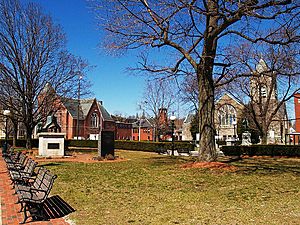
Leominster covers about 29.8 square miles (77.2 square kilometers). Most of this area is land, with about 0.9 square miles (2.3 square kilometers) being water.
The city is mostly located on a flat area above the Nashua River. The river flows through the eastern part of the city and then through the northern part, heading towards Fitchburg. The northern and western parts of Leominster have more hills. The North and South Monoosnoc Hills are the most important hills in the western part of the city. South Monoosnoc Hill is the highest point, at 1,020 feet (311 meters). In the 1800s, granite from the south hill was used to build house foundations. West of these hills are the No town Reservoir and Leominster State Forest. To the east, the Monoosnoc Brook flows through the city center and was an important power source for early factories.
Leominster's Villages
Leominster has several smaller areas called "villages." One is French Hill, a large hill with many "triple decker" apartment houses. It's called French Hill because many French immigrants settled there. In the early 1900s, Italian families also moved to Lincoln Terrace and formed a close community. Other areas include Morse Hollow, North Leominster, Rice Hill, the Flats, the Bowery, the West Side, and the Car Barn area. The Car Barn area is near the Fitchburg border and was named because trolley cars used to be stored and fixed there. Now, buses are used instead. You can find a special marker on Johnny Appleseed Lane that shows the birthplace of Johnny Appleseed.
Population and People
| Historical population | ||
|---|---|---|
| Year | Pop. | ±% |
| 1790 | 1,189 | — |
| 1800 | 1,486 | +25.0% |
| 1810 | 1,584 | +6.6% |
| 1820 | 1,790 | +13.0% |
| 1830 | 1,861 | +4.0% |
| 1840 | 2,069 | +11.2% |
| 1850 | 3,121 | +50.8% |
| 1860 | 3,522 | +12.8% |
| 1870 | 3,894 | +10.6% |
| 1880 | 5,772 | +48.2% |
| 1890 | 7,269 | +25.9% |
| 1900 | 12,392 | +70.5% |
| 1910 | 17,580 | +41.9% |
| 1920 | 19,744 | +12.3% |
| 1930 | 21,810 | +10.5% |
| 1940 | 22,226 | +1.9% |
| 1950 | 24,075 | +8.3% |
| 1960 | 27,929 | +16.0% |
| 1970 | 32,939 | +17.9% |
| 1980 | 34,508 | +4.8% |
| 1990 | 38,145 | +10.5% |
| 2000 | 41,303 | +8.3% |
| 2010 | 40,759 | −1.3% |
| 2020 | 43,782 | +7.4% |
| 2022* | 43,646 | −0.3% |
| * = population estimate. Source: United States Census records and Population Estimates Program data. Source: |
||
In 2000, there were 41,303 people living in Leominster. About 32.9% of households had children under 18. The average age of people in the city was 36 years old. For every 100 females, there were about 92.6 males.
The median income for a household was about $44,893. This means half of the households earned more than this, and half earned less. About 9.5% of the population lived below the poverty line.
Economy and Jobs
In 2000, the biggest job areas in Leominster were management and professional fields, employing over 32% of workers. Sales and office jobs made up 26.8% of the workforce, and education, health, and social services employed 20.2%.
Manufacturing still employed 25.5% of the city's workers. Most people (84.3%) drive alone to work, while 9.1% carpool. Only a small number use public transportation or walk. The average trip to work takes about 25 minutes. The company Nasoya, which makes soy products, was founded here in 1978.
Culture and Fun
Leominster has a rich cultural history with theaters, performance groups, and events. The Leominster Colonial Band, started by Italian immigrants in 1910, has given free summer concerts since the 1930s. Their yearly Christmas concert is also a popular tradition.
The Thayer Symphony Orchestra has been performing in Central Massachusetts since 1973. This orchestra includes professional musicians, volunteers, and students. Their concerts are so popular that they often sell out. The Central Massachusetts Repertory Theater has performed in Leominster since 1996. The Leominster Art Association also promotes art and holds an annual exhibition where they give a scholarship to a high school student.
Festivals and Events
The Starburst Festival happens every June at Doyle Field. It has live music, food, and fireworks, attracting over 8,000 visitors. During this festival, the "Citizens of the Year" awards are given to a man and a woman from Leominster.
In September, Leominster hosts the Johnny Appleseed Festival. This festival celebrates the fall season and the city's local hero, Johnny Appleseed. It takes place at Monument Square and features crafts, booths, entertainment, and a parade. The festival has over a hundred local booths and a food court with local restaurants and different cultural foods. Leominster used to have the National Plastics Center and Museum, but it closed in 2008.
Recreation and Parks
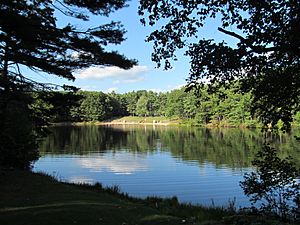
The Leominster Recreation Department takes care of many parks and playgrounds. Some notable parks include Monument Square, Arthur A. Fournier Sr. Memorial Park, and Barrett Park.
Doyle Field, located downtown, is the city's main sports complex. It has tennis courts, a soccer field, a track, a baseball field, a playground, and a stadium for football and soccer. Doyle Field opened in 1931 with seating for 6,200 people. Since 2005, it has been undergoing a big renovation project to improve the seating, add new turf, locker rooms, and more.
The Doyle Community Park & Center is a large open space with 167 acres. It is managed by the Trustees of Reservation. This area includes the Doyle Conservation Center, which is used for meetings and events.
Leominster is also home to the 4,300-acre Leominster State Forest. This is a popular place for hiking. Inside the forest, you can find Crow Hill Pond and Paradise Pond, which are great for picnics and swimming in the summer. In winter, the forest is open for cross-country skiing, snowshoeing, and snowmobiling.
There are also local golf courses like Monoosnock Country Club and Grand View Country Club.
Sports in Leominster
Leominster High School has a strong tradition of excellent sports teams. The Leominster High Blue Devils Football team is one of the most successful high school football programs in Massachusetts, with 12 State Super Bowl titles. Their main rival is the Red Raiders of Fitchburg High School. These two teams have played each other every year since 1894, including 112 consecutive Thanksgiving Day Games. This is one of the oldest high school football rivalries in the state. Leominster also has an ice hockey team that plays at the Wallace Civic Center.
Famous football players and coaches from Leominster include Lou Little, Ronnie Cahill, Shane Fallon, and Frank Novak.
The Wachusett Dirt Dawgs, a baseball team, played at Doyle Field from 2012 to 2017. Leominster is also home to the Central Mass Sabercats, a semi-pro football team.
The Leominster Dek-Hockey Center hosts youth dek-hockey games for Leominster and Fitchburg. It is located in North Leominster near Route 2.
Education in Leominster
Public schools in Leominster are managed by the Leominster Public School District. Leominster has four elementary schools for students in kindergarten through 5th grade: Fall Brook, Johnny Appleseed, Northwest, and Frances Drake. There are two middle schools, Samoset and Skyview, for grades 6-8. Leominster High School serves grades 9-12 and has both an academic part and a vocational part called the Center for Technical Education. The district also has three preschool programs.
Leominster also has two private Catholic schools: St. Leo Catholic School and St. Anna Catholic School.
For education after high school, students can attend the Leominster campus of Mount Wachusett Community College or Fitchburg State University in nearby Fitchburg.
The Leominster Public Library is the city's main public library. It was started in 1856 and moved to its permanent building in 1910. A rich person named Andrew Carnegie donated money for the new building, as long as the town promised to spend 10% of that amount each year to support the library.
Media and News
Newspapers
The Sentinel & Enterprise is a daily newspaper based in Fitchburg that covers news in Leominster. It was formed in 1973. The Leominster Champion is a weekly local newspaper. On the Scene Magazine is a monthly magazine about entertainment in the Leominster area.
Television
Leominster Access Television (LTV) is the city's public access TV station. It shows local programs and city meetings. LTV also broadcasts the annual Leominster-Fitchburg Thanksgiving football game every year.
Radio
Leominster has two radio stations. WCMX/1000 is a religious radio station that broadcasts during the daytime. WLPZ-LP/95.1 is a community radio station that started in 2017 and is run by volunteers.
Transportation in Leominster
You can take a commuter train from Boston's North Station to Leominster. The MBTA has a stop in North Leominster on its Fitchburg Line.
Local bus service is provided by the Montachusett Regional Transit Authority, also known as MART. This service operates in Leominster, Fitchburg, and Gardner.
The Fitchburg Municipal Airport is a public airport in nearby Fitchburg. It serves the area, but no major airlines have used it for regular flights in about 50 years.
Freight trains, which carry goods, are operated by CSX through the Fitchburg Secondary. These trains move goods to and from local businesses like Teknor Apex, a plastics factory, and WIN Waste Innovations, a garbage collection service.
Notable People from Leominster
- Rob Blanchflower, a football player drafted by the Pittsburgh Steelers.
- John Chapman, better known as Johnny Appleseed, a famous American pioneer who planted apple trees.
- Robert Cormier, author of popular books like I Am the Cheese and The Chocolate War.
- Mark Daigneault, a professional basketball coach.
- Paul DiGiovanni, a musician and former guitarist for the band Boys Like Girls.
- Dominik Dijakovic, a professional wrestler for WWE NXT.
- Rob Font, a mixed martial artist in the UFC.
- Paul Fusco, a famous photojournalist.
- Noah Gray, a professional football player for the Kansas City Chiefs.
- S. Wesley Haynes, an architect.
- Kathy Ann Kelly, an Irish-American singer and songwriter.
- Lou Little, a football player and coach from the 1940s and 1950s.
- Milt Morin, a former NFL tight end for the Cleveland Browns.
- Steve Moses, a professional ice hockey player.
- James Nachtwey, an award-winning war photographer.
- Mark Osowski, a former NBA assistant basketball coach.
- R. A. Salvatore, a fantasy and science-fiction author.
- Scott Spinelli, a college basketball coach.
- John J. Taylor, a former US Congressman.
- Oskari Tokoi, a Finnish-American politician and newspaper editor.
- David I. Walsh, a former Governor of Massachusetts and U.S. Senator.
- Matt Kelly, drummer for the band Dropkick Murphys.
Images for kids
See also
 In Spanish: Leominster (Massachusetts) para niños
In Spanish: Leominster (Massachusetts) para niños





